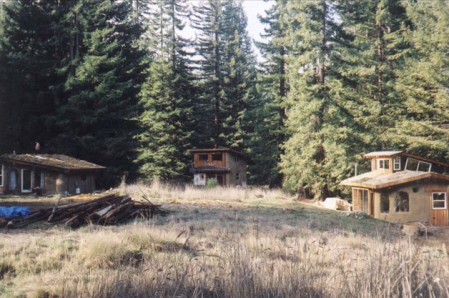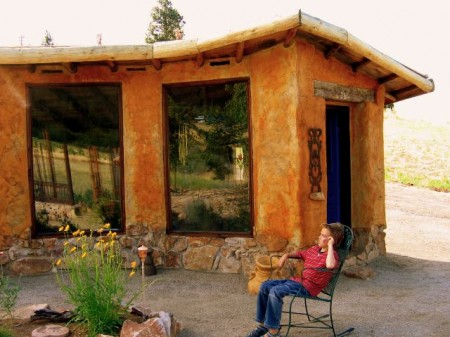Some days, don’t you feel the world crumbling around you? Financial crises, world hunger, war, poverty. It seems unending. Some people may feel that one way to escape is to have a small, comfortable place to come home to. A home that is like a hug, warm and alive.
Some people have found that feeling in a cob house. A hand sculpted structure that curves and comforts like the earth it is made from. The House Alive! company is offering workshops for 2009 on how to create your own small structure.
House Alive!, which was started in 2001 by Coenraad Rogmans, James Thomson and numerous volunteers, teaches workshops about natural building, natural design and appropriate technology. They also offer consulting services, do presentations and seminars and work to promote natural building as a real alternative to conventional construction methods.
Cob is a building material that is made of a mixture of sand, straw and clay. The materials are mixed wet, by foot or with a tractor or mortar mixer. The word “Cob” comes from an old English word meaning “Lump” or “Loaf.”
The wet cob mixture is used to build thick earth walls; the building technique is very similar to sculpting with modeling clay. Because cob building requires no forms, you can build your walls into any shape you choose. Curves, niches, arched windows and built-in furniture are common features in cob buildings.
Because cob can be labor intensive, it is best if a cob structure be kept on the small side.
House Alive! will be offering a workshop in May of 2009 on how to build a complete shelter. Participants of the workshop will leave confident that they can design and build their own natural home. The building techniques will include:
- Making cob by foot
- Rubble trench foundations
- Stem walls out of recycled concrete, earth bags, and stone
- Natural sub-floors for earthen floors
- The materials sand, straw, and clay: How they work, what to look for, where to find them
- Wall building: tapering, keeping it plumb, trimming, shaping
- Electricity: How to put in wires, how to build a circuit
- Plumbing: Water and gray water systems
- Windows, doors and hanging cabinets and other things on cob walls
- Hybrid buildings: The interfaces of cob with other materials
- Earthen floors
- Earthen finish plasters
Lectures and demonstrations will include
- The economy of building
- Passive solar design
- Natural design
- Composting toilets
- Solar hot water
- Solar electricity
- Codes, hybrid buildings and natural renovations
- Straw bale construction
- Light straw clay, adobe brick and waddle and daub.
- Roofs and roof insulation
- Simple living and community
One thing that cob building lends itself to is cohousing. Cohousing communities attempt to be as self-sufficient as possible, by building their own homes from sustainable materials like cob and straw bales and by growing their own food. The Emerald Earth Sanctuary in Mendocino County, Calif. makes decisions by consensus, and they value direct, open communication and conflict resolution. They also offer work parties, natural building workshops, and a work trade program.
If you are interested in learning more about cohousing, the 2009 cohousing conference will be in Seattle, June 24-28, 2009.

If you enjoyed this post, subscribe to our feed




Thanks so much for the link to the Coho/US National Conference!
I did want to share that cohousing is actually a bit more diverse than suggested by your statement that “Cohousing communities attempt to be as self-sufficient as possible, by building their own homes from sustainable materials like cob and straw bales and by growing their own food.”
I believe that this is true for a great many, if not most, cohousing communities, but not all. If you check out the cohousing directory in depth, link provided, you may more insight into the diversity that is cohousing. I promote cohousing as a way that you can increase sustainability, but this is not a universal value that is held in common by all cohousing communities. Cohousing is, generally, more sustainable just because the model requires that a community have common spaces, that are shared by all. This, generally, results in smaller private spaces, which is certainly more sustainable.
By the way, a very interesting blog entry!
Craig Ragland
Coho/US Exec. Dir.
Thanks Craig for more information on cohousing. I know it is a much wider subject than I mentioned above and I’m fascinated with the way cohousing works. I’m from Denmark, which is known for its collective type villages, so this way of life is very interesting to me.
Hello, Do something for help those hungry people from Africa or India,
I added this blog about this subject:
in http://tinyurl.com/6kv7fu
These houses are so beautiful. I have a question: I read a lot that they aren’t meant for cold climates, because the earth isn’t insulating enough against cold. What about someplace like Kansas or Missouri, where it gets very cold in the winter and very hot and humid in the summer?
Hi Julie,
Cob houses have been built in Great Britain and Ireland for more than 500 years and cob has been used as a material since pre-historic times. Most new cob homes have been built in CA, OR, WA and NM, so it seems to work in different climates.
I did find this cob/straw bale home in Mayetta, Kansas.
http://naturalhomes.org/cob-usa-mayetta.htm
I think the best resource for this kind of information is the Natural Building Network: http://www.naturalbuildingnetwork.org/cold_climate_cob.htm
The book, The Hand Sculpted House by the Cob Cottage Company is also one of the best resources I have found.
WOW! This is a totally new concept to me, but very appealing, for obvious reasons. What happens when it rains? I live in England. I want to build my studio our of this.
Hi Peter,
I guess there are quite a lot of cob houses in England, Wales, Ireland and Scotland. A lot of cob houses in the U.S. are in rainy Oregon and Washington. I have read that you do have to take precautions with the walls and have good roof/overhang coverage and good plastering. I heard that a good cob house starts out life with an excellent hat and pair of shoes (foundation).
I love what you have done here I have found a cob cottage here where I live on a peace of heaven nestled in the woods I would love to be the owner of if any of you would like to donate to the cause our family would highly be grateful